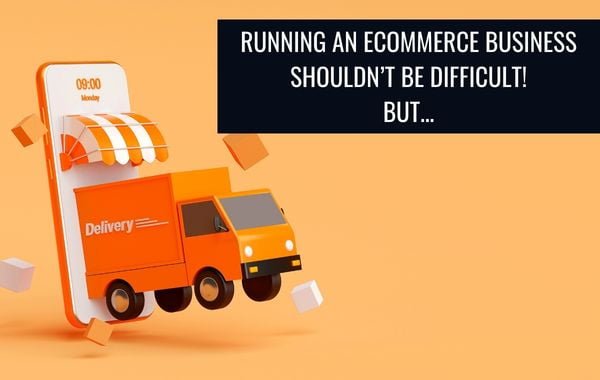Running an ecommerce business shouldn’t be difficult. That’s the driving narrative out there, but the reality is that setting up a successful ecommerce business takes a considerable amount of work.
Across the globe, ecommerce is growing rapidly and India’s Ecommerce sector is expected to reach US$111.40 billion by 2025 from US$46.20 billion in 2020.
Navigating the complexities of starting and growing an ecommerce business may be intimidating, but it’s a worthwhile endeavor. In this blog, we’ll cover the dominant narrative of ecommerce, dispel common misconceptions and provide helpful tips for setting up and managing a successful online store.

Table of Contents
What you need to know about setting up an ecommerce website
Contrary to popular belief, setting up an ecommerce website is not as simple as slapping up a few webpages and waiting for the money to start rolling in. Rather, it requires a significant investment of time and money.
First, you’ll need to register your business with the state, obtain a sales tax permit, and open a business bank account. Next, you’ll need to research and select technologies for hosting, payment processing and marketing. Depending on the scope of your store, technology costs can range from hundreds to thousands of dollars.
In addition, you’ll need to create your website, stock it with products and premium content, and develop a customer experience strategy.
Misconceptions about ecommerce
The idea that ecommerce is a “get-rich-quick” scheme is a dangerous misconception propagated by late-night infomercials and online snake oil salesmen. The truth is that it takes significant effort, capital and expertise to build a successful online store.
Many entrepreneurs make the mistake of underestimating the complexity of ecommerce and overestimating the potential rewards. This can lead to disastrous results, especially if entrepreneurs are not honest with themselves about the amount of effort and resources it will take to create a thriving store.
Understanding the competitive landscape
Another misconception is that the ecommerce space is devoid of competition. The truth is, established ecommerce players have had years to develop their brands, acquire customers and cement their positioning in the marketplace. To compete, you need to invest in channels such as search engine optimization, promotional campaigns and content marketing to drive traffic to your website and nurture leads into paying customers.
Maximizing customer retention
Retaining customers is just as important as acquiring them. Many ecommerce businesses struggle with this, as the cost of retaining a customer is typically higher than acquiring one.
To maximize retention, consider the following strategies: offer loyalty rewards, personalize customer communications, respond to customer inquiries quickly and efficiently, and focus on creating positive customer experiences.
Leveraging automation
Managing an ecommerce business requires a significant degree of manual labor. From accounting to postage, there is a wealth of tedious, low-value tasks that entrepreneurs must perform. Fortunately, there are many automated solutions available, such as e-mail service providers and software integrations.
By automating the mundane, time-consuming tasks that eat up most of your time, you can free up bandwidth to focus on higher value activities such as launching campaigns and improving customer experiences.
The importance of secure data storage
Data security is another factor that is often overlooked. Ecommerce businesses are vulnerable to data breaches, which can result in legal liabilities and financial costs. As such, it’s important to secure your data with industry-standard encryption technologies and follow best practices in data storage and management.
Navigating tax and government compliance
Tax regulations are daunting and vary from one jurisdiction to another. It’s important to understand the local, state and federal regulations for your ecommerce business to ensure that you remain compliant and avoid costly mistakes.
Streamlining post-sale operations
Once a purchase has been completed, there are a variety of tasks that need to be carried out. These can include order fulfillment, customer service, shipping, and returns processing.
To streamline these operations, many ecommerce businesses turn to third-party fulfillment and shipping solutions. This can save you time and resources while ensuring that customers have an excellent experience with your business.
Measuring performance
Tracking and analyzing the performance of your ecommerce business is important in order to ensure that you’re taking the right steps to grow and improve. Consider tracking key performance indicators such as weekly sales revenue, cost of customer acquisition and average order value.
This will help you analyze trends, make improvements and plan for the future.
A Few Helpful Tips for Running an Ecommerce Business
Adapt to Customer Needs
It’s essential to stay up to date with the changing tastes and preferences of customers, ensuring that your product range meets their needs. You can do this by analyzing customer feedback as well as competitor websites and products.
Create an Omnichannel Experience
Today’s shoppers demand a seamless experience across all channels, so it’s important to ensure that whatever channel they choose (retail store, online store, or mobile app) they get consistent services and a pleasing experience.
Build Trust
As an ecommerce business, your customers have to trust you in order to make a purchase. Make sure your site accurately describes each product and includes honest customer reviews. This will help to build trust and encourage customers to buy.
Provide Good Customer Service
Ensure you provide fast , efficient customer service that meets and exceeds customers’ needs. Offer 24-hour live chat support or a toll-free number for customers to call with their queries.
Invest in Security
Investing in security is essential for an ecommerce business. Put measures in place to ensure that any personal data collected is kept secure, and that online transactions can’t be manipulated by hackers.
Tips for success
Running a successful ecommerce business requires substantial time, effort and resources. Here are five tips to help you succeed:
- Not all ecommerce solutions are created equal. Compare the features, pricing and security solutions of services such as Shopify and BigCommerce before making a decision.
- Keep your customers in the loop. Let them know about order status updates, product launches, sales and more to keep them engaged.
- Design your website for user experience. Use intuitive navigational elements and product images to provide a smooth shopping experience.
- Leverage email automation. Use tools such as MailChimp and Klaviyo to schedule email campaigns, capture customer feedback and send automated reminders.
- Don’t forget about marketing. Develop campaigns to drive traffic to your website, grow your customer base and increase sales.
Setting up and running an ecommerce business isn’t easy, but it can be a rewarding endeavor. By acknowledging the complexity of the initiative, understanding the competitive landscape and being mindful of data storage and taxation policies, entrepreneurs can have a successful ecommerce store.
If you’re looking for help or advice on getting your ecommerce business off the ground, get in touch with us. We have expert teams and resources that can supercharge your ecommerce success. Contact for a free consultation





